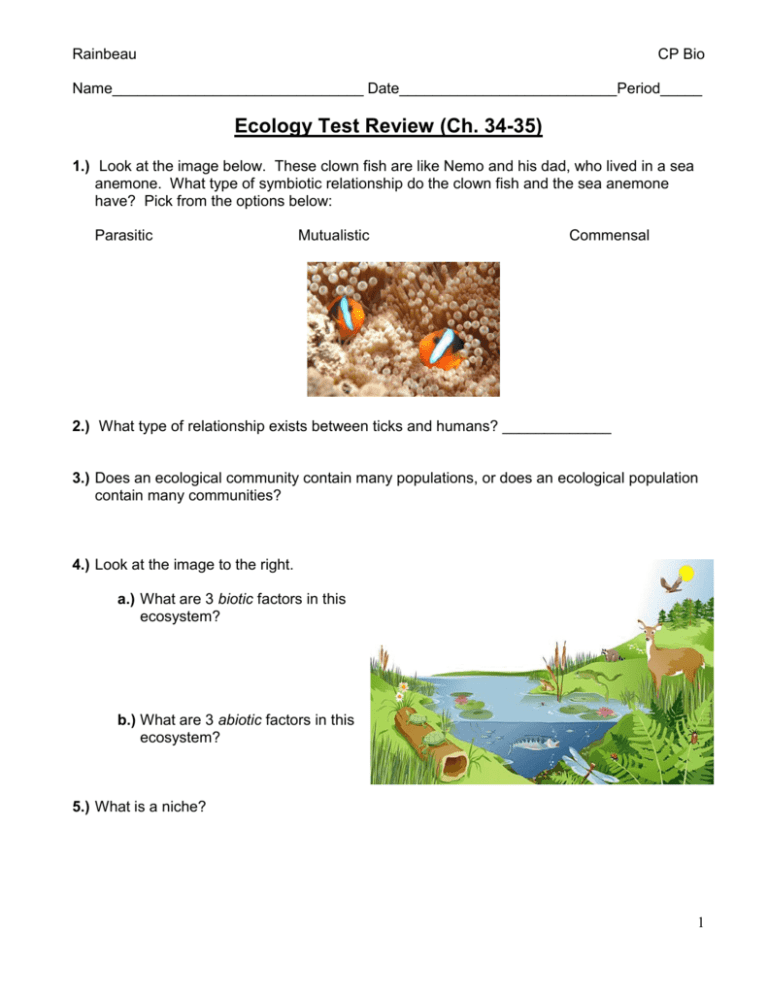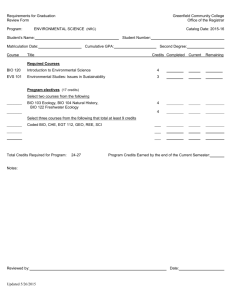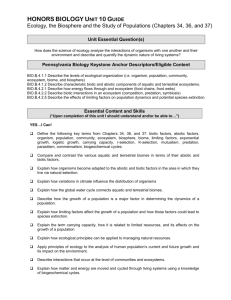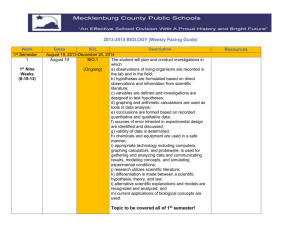Ecology Test Review Packet
advertisement

Rainbeau CP Bio Name______________________________ Date__________________________Period_____ Ecology Test Review (Ch. 34-35) 1.) Look at the image below. These clown fish are like Nemo and his dad, who lived in a sea anemone. What type of symbiotic relationship do the clown fish and the sea anemone have? Pick from the options below: Parasitic Mutualistic Commensal 2.) What type of relationship exists between ticks and humans? _____________ 3.) Does an ecological community contain many populations, or does an ecological population contain many communities? 4.) Look at the image to the right. a.) What are 3 biotic factors in this ecosystem? b.) What are 3 abiotic factors in this ecosystem? 5.) What is a niche? 1 Rainbeau CP Bio 6.) When does exponential population growth happen? 7.) Complete the graph below by drawing the characteristic shape of exponential population growth. 8.) When does logistic population growth happen? 9.) Complete the graph below by drawing the characteristic shape of logistic population growth. 10.) Circle the letter of each instance when a population’s growth will slow down. a.) The birthrate and death rate are the same. b.) The birthrate is greater than the death rate. c.) The rate of immigration is equal to the rate of emigration. d.) The rate of emigration is less than the rate of immigration. 11.) What are possible limiting factors of any population? 12.) What is the carrying capacity of an environment? 2 Rainbeau CP Bio 13.) Describe how the growth cycles of the lynx and the snowshoe hare (rabbit) populations are related. 14.) How does the lynx population illustrate a “boom-and-bust” growth pattern? 15.) 140 wolves live in a forest that is 225 square kilometers (km2) in size. What is the density of this wolf population? 16.) Why did the human population grow very slowly for most of human history? 17.) Circle the letter of each reason why the human population began to grow more rapidly about 500 years ago. a.) Improved sanitation and health care reduced death rate. b.) Industry made life easier and safer. c.) The world’s food supply became more reliable. d.) Birthrates in most places remained low. 18.) What countries are contributing the most to current population growth – developed or less developed? Explain. 19.) What may cause the growth rate of the world human population to level off or even slow down? 3 Rainbeau 20.) CP Bio Use the age-structure diagrams below to answer questions a & b. a.) Which country is expected to have more rapid growth in the future? Explain. b.) Which country is probably more developed than the other? Explain. COUNTRY A COUNTRY B Ecology Test Review (Ch. 36) 21.) Look at the image to the right and answer questions a- d. a.) Is this a food chain or a food web? b.) Based only on the information in this picture, is the deer an herbivore, omnivore, or a carnivore? c.) Based only on the information in this picture, is the snake an herbivore, omnivore, or a carnivore? d.) What are the top-level consumers of this ecosystem? 4 Rainbeau CP Bio 22.) Look at the food chain below. How many trophic levels are in this food chain? 23.) Look at the food chain above. Who is the primary consumer? 24.) Look at the energy pyramid to the right. Answer questions a-d. a.) What is the producer in this ecosystem? b.) Which trophic level has the most energy? c.) If the “Fish and other carnivores” have 100 Kcal of energy, how much energy will be passed to the Bass when it eats them? d.) In what form is energy lost from all ecosystems? The Carbon Cycle (use the diagram below for questions 25-33) 25.) What biological process removes CO2 from the atmosphere? 26.) What are two biological (natural) processes that add CO2 to the atmosphere? 27.) What human activity is adding too much CO2 to the atmosphere? What is the consequence of this high level of atmospheric CO2? 5 Rainbeau CP Bio 28.) What is the process that producers perform that turns atmospheric carbon into carboncontaining molecules that all living things can eat (like sugars)? 29.) How/From where do consumers get new carbon atoms? 30.) When consumers and producers burn sugar for energy, they create a carbon-containing waste product. What carbon-containing molecule do we release as waste? 31.) Why are decomposers so important for the cycling of chemicals like carbon throughout ecosystems? 32.) List two things humans do that are overloading the carbon cycle with carbon dioxide. 33.) What is the major consequence of releasing too much carbon dioxide into the atmosphere? 34.) How does the movement of energy and matter (nutrients) through ecosystems differ? 35.) True or False: Energy can be recycled and reused. 36.) True or False: Producers create energy for consumers. 37.) Other than contributing to global warming, what are three other ways human activity is harming the planet? 6








